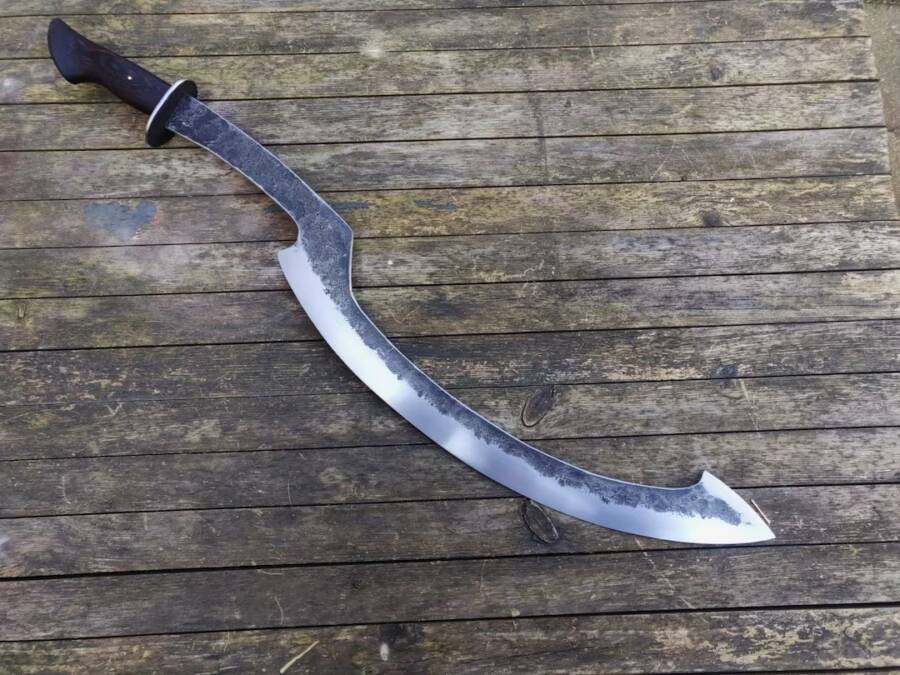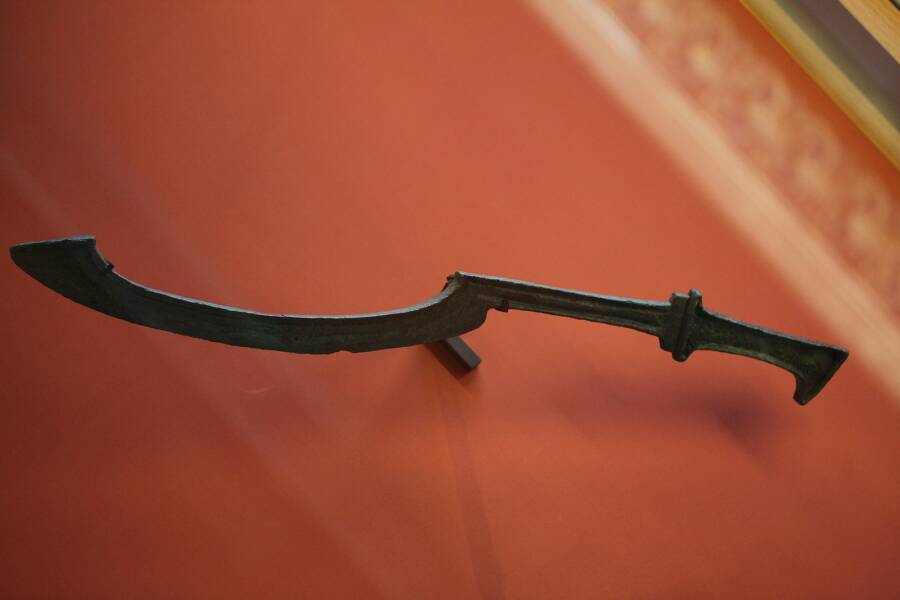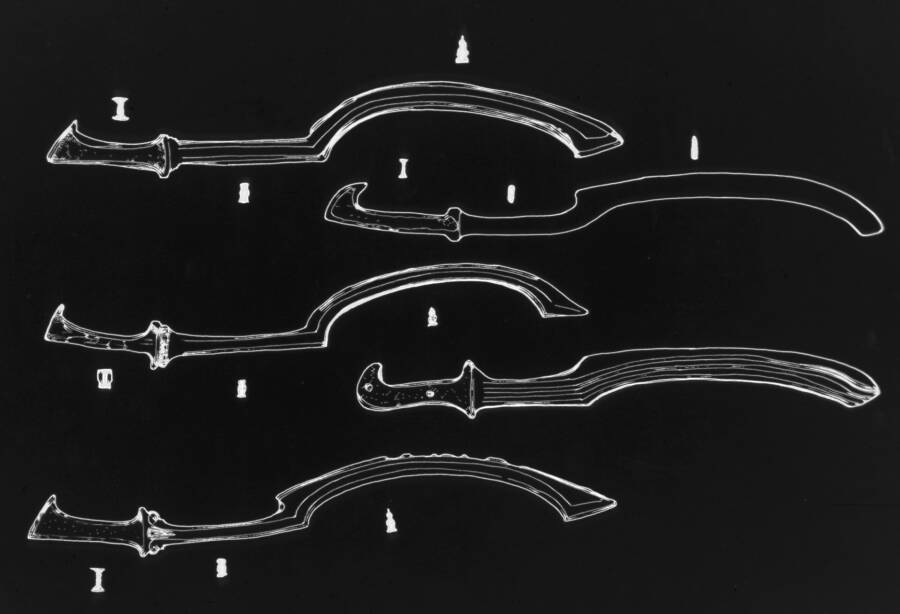The khopesh first appeared in Sumer in the 3rd century B.C.E., but it would not make a mark on history until it was adopted by the growing New Kingdom of ancient Egypt.

TwitterThe unique, hook-shaped design of the khopesh made it a formidable and versatile weapon.
Throughout history, key moments of discovery have propelled humanity further along its evolutionary journey. We’ve come to define these early human eras by these moments — the Stone Age, the Bronze Age, and the Iron Age. Within these ages came a series of significant inventions that redefined how humans interacted, whether with the world around them or with one another.
For example, the creation of early farming tools allowed humans to cultivate the land. No longer were we required to venture into the wilderness in search of plants to gather or animals to hunt.
Likewise, the creation of various types of weaponry, as we neared the end of the Bronze Age and entered the Iron Age, enabled humans to kill each other more effectively. This led to the rise of sprawling empires, the likes of which the world had never before seen.
One prime example of how a weapon could help to change the course of history was the khopesh, a sword used in ancient Egypt that allowed the budding empire to blossom.
The Origins Of The Khopesh
While the khopesh has been historically linked to Egypt around 1500 B.C.E., its origins date back around 1,000 years and to an entirely different area: Sumer in the third millennium B.C.E.
According to Ancient Origins, despite widely being considered a sword, the khopesh evolved from early Bronze Age copper axes. Axes served purposes that didn’t involve combat but were also used as weapons when needed. The issue was that copper was a fairly weak metal, and ancient civilizations were severely limited in what they could craft.
The metallurgic processes required to make swords rendered copper unsuitable for the purpose. However, as humans steadily came to incorporate bronze, an alloy of copper and tin, into their craftwork, new possibilities opened up.
The more robust metal was far more suited to withstand the delicate process of shaping and forging more advanced tools. Suddenly, humans weren’t limited to the small tips of spears and axes; they could create lengthy pieces of bronze, sharpened to an edge to create a blade.

Wikimedia Commons Khopesh-like swords appeared in cultures across Africa and the Middle East.
Ancient Sumerians likely first crafted the khopesh to be multifunctional — its curved shape allowed it to perhaps cut, slash, chop, or thrust. In the early years of the khopesh’s use, body armor was not made to withstand slashing in such a manner. As time went on, however, the khopesh still proved a formidable weapon.
Certain relatives of the khopesh saw the blade not just curve but circle around almost entirely in the shape of a sickle. This shape allowed the wielder to thrust toward an enemy, hook his shield, and tear it away from him in one fluid motion. Its versatility made it all the more fearsome in battle.
The Unique Weapon Makes Its Way To Egypt
As this advanced weapon rose in popularity, it spread throughout regions of the Mediterranean Levant, comprising the Mediterranean coast of the Middle East to present-day Turkey, eventually reaching the Canaanite city-states. Although it only arrived in ancient Egypt around 1550 B.C.E., it quickly became a favored weapon during the nascent New Kingdom period.
According to Sword Encyclopedia, the khopesh served both as a versatile military weapon and a symbol of royal power. It was a popular weapon and appeared among depictions of many Egyptian rulers, including the queen Nefertiti and, more famously, the pharaoh Ramses II, shown wielding a khopesh in battle.

Wikimedia CommonsA khopesh dedicated to the pharaoh Ramses II.
The khopesh also served numerous ceremonial roles in ancient Egypt. In a temple dedicated to Hatshepsut in Deer el-Bahri, for example, there are portrayals of soldiers, each wielding a khopesh. However, these were likely wooden imitations of the bronze sword used during a pharaoh’s funeral for ceremonial swordplay.
In addition to its more reverent uses, there are also various depictions of the khopesh being used to dismember prisoners and smite the condemned.
The Lasting Impact Of The Khopesh
While the khopesh can’t be given sole credit for the rise of the Egyptian Empire’s New Kingdom during the later Bronze Age — there were numerous contributing factors — the sword did, in some manner, seem to give the military a tactical edge.
The usefulness of the khopesh’s design elements is further evidenced by the appearance of similar types of weaponry in various other cultures across the globe. According to Sword Scholar, the Greeks used a sword known as kopis for centuries.

Wikimedia CommonsIllustrations of various types of Bronze Age sickle-swords.
The khopesh was also used by the Hittites, an ancient group who founded an empire across Asia Minor and Syria and frequently fought against the Egyptians.
Elsewhere, across regions of eastern and central Africa, researchers have found evidence of other blades similar to the khopesh. In Burundi and Rwanda, archaeologists have unearthed sickle-shaped daggers comparable to the khopesh. However, it’s not entirely clear if they inherited this blade-making tradition from Egypt or discovered the design independently.
Likewise, khopesh-like swords and daggers have also been found in southern India and parts of Nepal.
No matter how you slice it, the khopesh had a monumental impact on the culture and development of ancient Egypt, allowing the Egyptian Empire to remain sovereign for an extended period. The fact that the design spread so far across various cultures indicates that it was an effective and sought-after tool and weapon.
The rise of Egypt’s New Kingdom can’t be solely attributed to the khopesh. Still, it’s fascinating to see how such a seemingly minor object can help influence the course of history.
After learning about the khopesh and its influence on history, learn all about the Rosetta Stone, the tablet that solved the mystery of ancient Egyptian hieroglyphs. Then, read about when researchers discovered an Egyptian ramp and what that may tell us how the pyramids were built.





